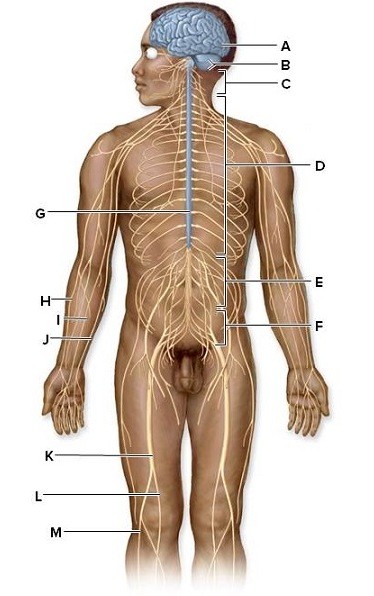Use the word bank to identify the labeled structures pictured below: sacral nerves, lumbar nerves, brain, common fibular nerve, ulnar nerve, spinal cord, cranial nerves, thoracic nerves, cervical nerves, radial nerve, tibial nerve, median nerve, sciatic nerve  A:________B:________C:________D:________E:________F:________G:________H:________I:________J:________K:________L:________M:________
A:________B:________C:________D:________E:________F:________G:________H:________I:________J:________K:________L:________M:________
What will be an ideal response?
A: brain
B: cranial nerves
C: cervical nerves
D: thoracic nerves
E: lumbar nerves
F: sacral nerves
G: spinal cord
H: radial nerve
I: median nerve
J: ulnar nerve
K: sciatic nerve
L: tibial nerve
M: common fibular nerve
You might also like to view...
3) There were numerous cases throughout the United States of patients having bloody diarrhea all within a week of each other, many of which were hospitalized with severe cases. Although the people spanned from California to New York, they all had attended a high school graduation party. Epidemiologists determined the common food factor was cheese curds homemade by a farmer. The home where the cheese curds were made was searched, and the cheese curds and milk used to produce them were taken to the local government lab. Among other microbes, Campylobacter jejuni was isolated from many of the cheese curds as well as the farmer's bulk tank milk. What should be done for those infected? What can be done to prevent this from happening again?
What will be an ideal response?
Auxotroph bacteria
a. are mutant bacteria b. can grow on minimal media c. feed on proteins d. make their own nutrients e. make antibiotics
Which of the following statements about stratified temperate zone lakes is NOT true?
A. Temperature gradients change from summer to winter. B. Solar radiation warms the surface layers in summer. C. Rich nutrients from the continual production of detritus accumulate near the surface of the lake. D. Populations of plankton and zooplankton depend on both sunlight and nutrient levels. E. Wind aids in the circulation of water.
Which organ detects and responds to changes in blood glucose levels?
A. liver B. thymus C. gallbladder D. pancreas E. thyroid